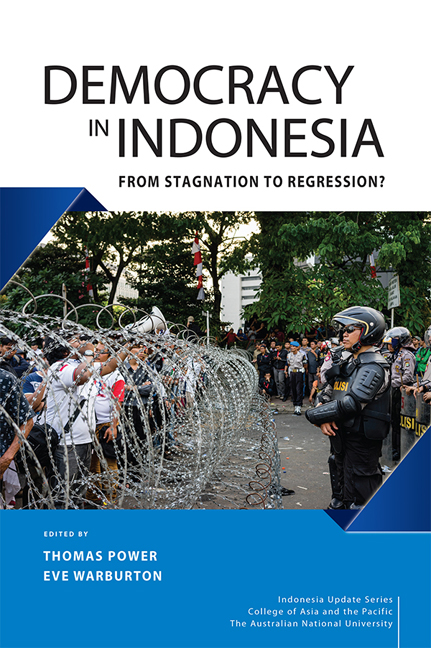Book contents
- Frontmatter
- Contents
- Tables and Figures
- Contributors
- Foreword
- Acknowledgments
- Glossary
- 1 The decline of Indonesian Democracy
- Part 1 Historic al and Comparative Perspectives
- Part 2 Polarisation and Populism
- Part 3 Popular Supp ort for Democracy
- Part 4 Democratic Institutions
- Part 5 Law, Security and Disorder
- Index
- Indonesia Update Series
17 - Electoral violence in Indonesia 20 years after reformasi
Published online by Cambridge University Press: 24 November 2020
- Frontmatter
- Contents
- Tables and Figures
- Contributors
- Foreword
- Acknowledgments
- Glossary
- 1 The decline of Indonesian Democracy
- Part 1 Historic al and Comparative Perspectives
- Part 2 Polarisation and Populism
- Part 3 Popular Supp ort for Democracy
- Part 4 Democratic Institutions
- Part 5 Law, Security and Disorder
- Index
- Indonesia Update Series
Summary
Over the past two decades, Indonesia has been acknowledged as the world's third-largest democracy and largest Muslim-majority democracy. By 2019, the country had smoothly run four direct presidential elections, five parliamentary elections and hundreds of direct local elections (pilkada). Voter participation rates in national elections have hovered around 70 per cent over the years, with greater variation in local executive elections. Following Suharto's resignation in 1998, Indonesia shifted to a multiparty system in which hundreds of thousands of candidates compete across a multitude of legislative and executive races. On 17 April 2019, Indonesia held its most complicated election in history. Billed as one of the world's largest simultaneous elections, the 2019 election saw over 80 per cent of 190 million registered voters cast their vote simultaneously for their local council representatives, parliament members and president in more than 800,000 polling stations across the archipelago. Despite the complicated logistical undertaking, the election proceeded without major incidents of violence.
These successes notwithstanding, many Indonesia specialists have expressed concerns over the quality of democracy in recent years (e.g. Aspinall 2018; Hadiz 2017; Lindsey 2018). An increase in government crackdowns on critics and the politicisation of identities around elections (Warburton and Aspinall 2017), among other indicators, have been identified as worrying symptoms of democratic deterioration. While the 2019 national election went smoothly, the announcement of its results a few weeks later spurred protests by Prabowo Subianto's supporters and a two-day riot that claimed ten lives and injured at least 200 people (BBC 2019; Halim 2019). The authorities deployed more than 40,000 troops, arrested hundreds of rioters and shut down access to social media for several days to prevent the spread of what it termed ‘hoaxes’ and ‘fake news’ (Straits Times 2019). While order was restored within a few days, authorities claimed that the outburst was purposefully planned to discredit election results, and promised to thoroughly investigate the provocateurs involved (Chan 2019).
This outburst of post-election violence raises a few important questions: To what extent is electoral violence a common occurrence in Indonesia? What can patterns of electoral violence tell us about the country's quality of democracy? Did the May 2019 riots mark a shift to more violence around elections in Indonesia?
- Type
- Chapter
- Information
- Democracy in IndonesiaFrom Stagnation to Regression?, pp. 346 - 370Publisher: ISEAS–Yusof Ishak InstitutePrint publication year: 2020



